How Big Do Black Tail Gold Fish Get
If you want to know how to identify what type of goldfish you have, you need to look at its features. Here are some unique features that make identifying your goldfish simple. There are hundreds of types of goldfish, many that have been cross bred which take on a mix of different features.
Search Types:
Full List | Common | Comet | Shubunkin | Wakin | Fantail | Ryukin | Veiltail | Oranda | Telescope | Black Moor | Ranchu | Pompon | Pearlscale | Celestial | Bubble Eye
Hardy Goldfish Types
A body shape that has an elongated flattened football shape include: The Common, the Comet, Shubunkin. (good breeds for an outdoor goldfish pond).The common, comet and shubunkin look very similar in shape and colors.
- The comet has longer fins and most notably its tail fin is much longer.
- The common doesn't come in calico but the comet and shubunkin do.
- The shubunkin is only calico so if it's calico with short fins, it can't be a common.
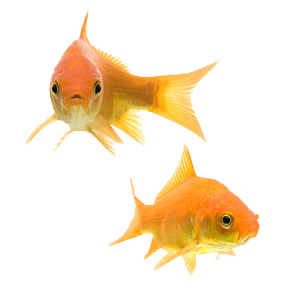
Fancy Goldfish Types
An egg shape body shape are considered the fancy breeds and can include: Fantail, Ryukin, Veiltail, Oranda, Telescope, Black Moor, Panda Butterfly, Ranchu, lionhead, Pompon, Pearlscale, Hama Nishki, Celestial and Bubble-Eye.The mature oranda, ranchu and lionhead has a wart like wen hood cover over its face and head
- The oranda has a dorsal fin and the lionhead and most ranchu don't.
- The ranchu has a prominent arch in its back and downward pointed tail fins.
- The lionhead and oranda have a straighter back line.
- A goldfish with a hood cover with a straight back and no dorsal fin is a lionhead.
The fantail, ryukin and veiltail have similar egg-shaped bodies with no distinct features like a hood cover or globe eyes
- The fantail and ryukin have sturdy upright fins and tails.
- The ryukin has a more prominent hump that the dorsal fin sits on than the fantail.
- The veiltail has long flowing fins and tail.
The telescope, black moor and panda butterfly have their eyes on the sides of ball like protuberances
- A black moor is a telescope/globe-eye but is only black or faded black in color.
- The panda butterfly resembles the colors of a panda bear, clear sections of black and white.
The pearlscale and hama nishiki have a golf ball body shape with scales that stand out like little white domes
- the hama nishiki has a slight hood cover on top of its head while the pearlscale does not.
The celestial has bulging eyes that point upward and no dorsal fin. The bubble eye has two bubble shaped check pouches
List of Goldfish
- American Shubunkins
- Bristol Shubunkins
- Bubble Eye
- Butterfly Tail
- Celestial Eye
- Comet
- Common
- Curled-gill
- Eggfish
- Fantail
- Imperial
- Izumo Nankin
- Jikin
- Lionchu
- Lionhead
- London Shubunkins
- Moor
- Nymph
- Oranda
- Panda Telescope
- Pearlscale
- Pompom
- Ranchu
- Red Cap Oranda
- Ryukin
- Sabao
- Shukin
- Tamasaba
- Telescope
- Tosakin
- Veiltail
- Wakin
- Watona
— Back to Top —
The Common Goldfish
Carassius AuratusAsian in origin, the common goldfish is a member of the Cyprindae fish family. The common goldfish is related to the many species of carp, koi and other types of breeds. The name Auratus literally means "overlaid with gold". This species of fish has been raised by humans for over a thousand years and sometime during this period, they became family pets.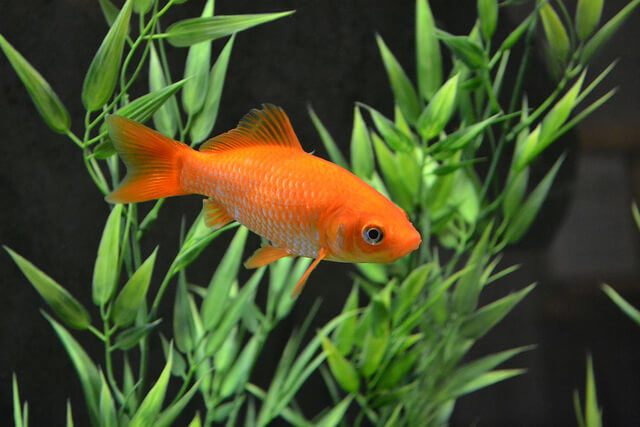 The common goldfish is a great fish for beginners since it's a very hardy breed of goldfish. It can live in water with temperatures ranging from 55-80*F (12-26*C), with a pH of 6-8, which is much like tap water. The common goldfish doesn't require a heater and needs only minimal care if placed by itself in a well filtered 10-gallon aquarium (38 liters). In the wild, you can find these in freshwater, lakes, rivers, canals and even ditches that have adequate vegetation. This water can be slow moving to stagnant. They do best in cooler water around the low 70s.Goldfish are however social animals and would benefit from having a tank mate. You can keep two of three small goldfish (a few inches or less) in a 10-gallon tank but when they mature, you will likely need to upgrade your tank size. A goldfish that is properly cared for can live for well over five years (40 years plus max) and grow to around 12 inches long, 32cm (4 inches average, 10cm).A small one-gallon goldfish bowl (3.7 liters) is not highly recommended. When you place a goldfish in a small space like a bowl, the water gets dirty fast and make the goldfish unhealthy. Read the next post for beginners: goldfish bowl size for more info. If space is an issue, consider buying a fancy Beta fish or cold-water minnows which will do better in a small space than a goldfish would.A Beta needs good water parameter too but it also has the ability to breath oxygen through its mouth in addition to breathing through its gills. This just means they can live in stagnant water with low oxygen levels much better than other fish species. Even with this species, you will still need to perform routine maintenance to keep them healthy and happy.
The common goldfish is a great fish for beginners since it's a very hardy breed of goldfish. It can live in water with temperatures ranging from 55-80*F (12-26*C), with a pH of 6-8, which is much like tap water. The common goldfish doesn't require a heater and needs only minimal care if placed by itself in a well filtered 10-gallon aquarium (38 liters). In the wild, you can find these in freshwater, lakes, rivers, canals and even ditches that have adequate vegetation. This water can be slow moving to stagnant. They do best in cooler water around the low 70s.Goldfish are however social animals and would benefit from having a tank mate. You can keep two of three small goldfish (a few inches or less) in a 10-gallon tank but when they mature, you will likely need to upgrade your tank size. A goldfish that is properly cared for can live for well over five years (40 years plus max) and grow to around 12 inches long, 32cm (4 inches average, 10cm).A small one-gallon goldfish bowl (3.7 liters) is not highly recommended. When you place a goldfish in a small space like a bowl, the water gets dirty fast and make the goldfish unhealthy. Read the next post for beginners: goldfish bowl size for more info. If space is an issue, consider buying a fancy Beta fish or cold-water minnows which will do better in a small space than a goldfish would.A Beta needs good water parameter too but it also has the ability to breath oxygen through its mouth in addition to breathing through its gills. This just means they can live in stagnant water with low oxygen levels much better than other fish species. Even with this species, you will still need to perform routine maintenance to keep them healthy and happy.
— Back to Top —
Comet
The Comet Goldfish, thought to have originated from the state of Washington in the late 1800s, comes in several variations, the most popular being the orange metallic comet whose color shows well in goldfish ponds. Other variations come in an array of calicos; calico varieties like the red and silver sarassa comet. Many of the color combinations come in colors like red and white, black and orange, yellow, red, black, and of course goldfish orange.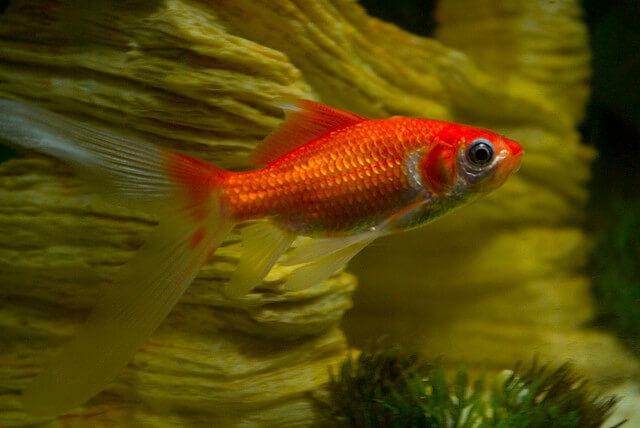 The comet goldfish is similar to the common goldfish types and is often mistaken for it, but the comet has a more slender body with more noticeable and elongated fins; especially the caudal fin, which is more than half to three-quarter the size of its own body. The caudal fin will also be much more pointed on its ends compared to the common goldfish. The comet goldfish will also have two pectoral fins and pelvic fins; while the dorsal fin, anal fin, and caudal fin will be single.
The comet goldfish is similar to the common goldfish types and is often mistaken for it, but the comet has a more slender body with more noticeable and elongated fins; especially the caudal fin, which is more than half to three-quarter the size of its own body. The caudal fin will also be much more pointed on its ends compared to the common goldfish. The comet goldfish will also have two pectoral fins and pelvic fins; while the dorsal fin, anal fin, and caudal fin will be single.
— Back to Top —
Shubunkin
The shubunkin goldfish comes in two varieties (London shubunkin and Bristol shubunkin). Its body looks much like the common or comet goldfish, but its colors resemble that of what you would find in a fancy goldfish type. It has one caudal tail fin, one dorsal fin, and paired pectoral and pelvic fins. The Bristol is larger, and its caudal fin is more rounded than that of the London.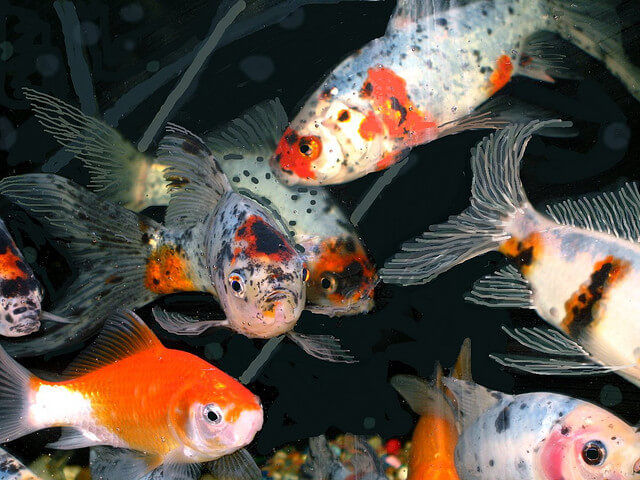 The color of the shubunkin goldfish should be calico. 25% of its color should be a blue-silver color that acts as a background for its other body colors. An even coat of strong black dots and colors that run into the shubunkins fins is the desired look for show goldfish. Both the London and Bristol variety is one of the hardier types of goldfish. This makes it an ideal goldfish for an outdoor pond or an indoor goldfish aquarium. If you do choose to stock your tank or pond with shubunkins, avoid mixing them with the slow-moving bubble eyes or celestial goldfish. The faster-moving shubunkins will out eat these other goldfish types which could lead to them being starved.
The color of the shubunkin goldfish should be calico. 25% of its color should be a blue-silver color that acts as a background for its other body colors. An even coat of strong black dots and colors that run into the shubunkins fins is the desired look for show goldfish. Both the London and Bristol variety is one of the hardier types of goldfish. This makes it an ideal goldfish for an outdoor pond or an indoor goldfish aquarium. If you do choose to stock your tank or pond with shubunkins, avoid mixing them with the slow-moving bubble eyes or celestial goldfish. The faster-moving shubunkins will out eat these other goldfish types which could lead to them being starved.
— Back to Top —
Wakin
The wakin goldfish is a popular breed in Japan. It's thought to be the common goldfish of East Asia. The Wakin goldfish resembles the comet goldfish with an elongated body but has a double caudal tail fin much like the fantail goldfish, only shorter. Only the wakin and jikin goldfish have an elongated body and double anal and caudal fins. The wakin goldfish is a hardy breed that is best placed in a goldfish pond. If it's placed in a goldfish tank, the tank should be large enough to accommodate its growth of over a foot long (30cm). It's not an aggressive goldfish breed but is a fast swimmer with a big appetite and so the wakin goldfish isn't a good tank mate for any slow swimming goldfish breeds. the appetite of the wakin goldfish can be a problem if the tank or pond contain live aquatic plants that it finds tasty. The most common colors of the wakin goldfish are a solid red or a variegated red and white color. The ideal balance of red and white colors should be half and half, but some goldfish might only contain a few small stripes of red on an otherwise white body; or vice versa. The reds should be deep and colorful, great for a goldfish pond. Other colors include metallics or variegated: oranges, yellows, browns and blacks.
— Back to Top —
Japanese Ryukin
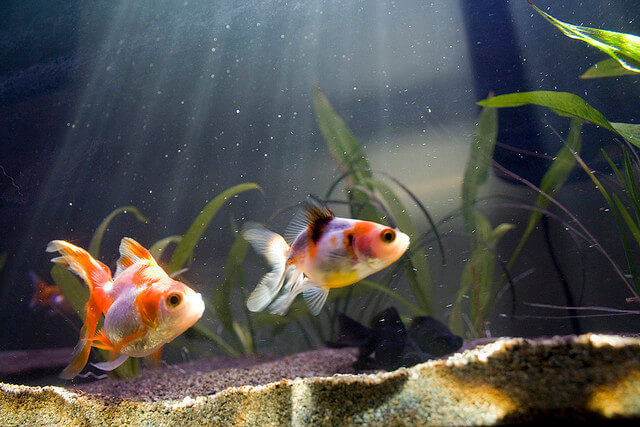 The ryukin goldfish from the Ryukyu Islands is a popular goldfish bred in Japan. It looks similar to the fantail goldfish but stands apart with a prominent hump towards the back of its head which elevates the dorsal fin. The long caudal tail fins can have three or four lobes, with the three-lobed ryukin having what the Japanese call a 'cherry blossom petal tail.' There are several goldfish types of ryukin, the yamagata kingyo, sabao, and tamasaba that have been bred to only have a single caudal tail fin. Ryukin goldfish come in a variety of color combinations, including: solid colors (self-colored) and multiple colors (variegated) of a deep red, red and white, blue, white, calico and more. A hardy variety of goldfish, the ryukin can be placed in your outdoor goldfish pond or introduced into a goldfish aquarium with other goldfish without any need for extra care. Good tank mates include the oranda, lionhead, or Ranchu Goldfish. Be careful that your bubble eye, and telescope goldfish breeds are not being bullied around by these tougher breeds.
The ryukin goldfish from the Ryukyu Islands is a popular goldfish bred in Japan. It looks similar to the fantail goldfish but stands apart with a prominent hump towards the back of its head which elevates the dorsal fin. The long caudal tail fins can have three or four lobes, with the three-lobed ryukin having what the Japanese call a 'cherry blossom petal tail.' There are several goldfish types of ryukin, the yamagata kingyo, sabao, and tamasaba that have been bred to only have a single caudal tail fin. Ryukin goldfish come in a variety of color combinations, including: solid colors (self-colored) and multiple colors (variegated) of a deep red, red and white, blue, white, calico and more. A hardy variety of goldfish, the ryukin can be placed in your outdoor goldfish pond or introduced into a goldfish aquarium with other goldfish without any need for extra care. Good tank mates include the oranda, lionhead, or Ranchu Goldfish. Be careful that your bubble eye, and telescope goldfish breeds are not being bullied around by these tougher breeds.
— Back to Top —
Fancy Fantail
The body of the Fantail Goldfish should be about three-fifths of its overall length and have an egg shape appearance. The only single fin on the fantail goldfish is the dorsal fin; all other fins are paired, including the caudal fin which is split down the middle with a forked appearance on each fin. Regardless of the fantail's fin, all are sturdy and rounded at the end to resemble, what else, blades of a fan. This is most noticeable when viewing the caudal tail fin from directly above.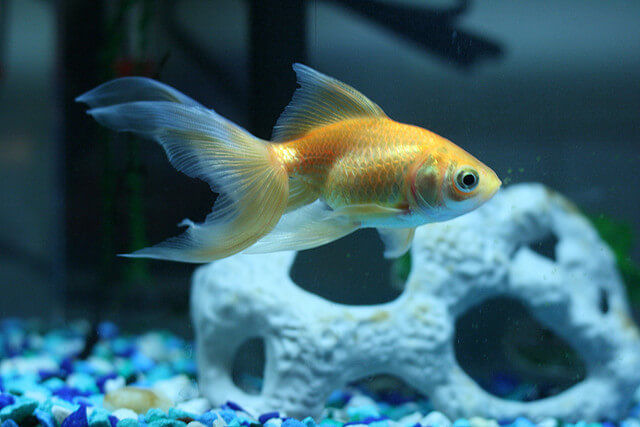 Fantail goldfish come in an array of colors from metallic self-colored (single color) to a variegated (multiple colors), including calico. The color of the variegated variety should extend into the fins and the calico variety should be mainly blue with patches of other colors. Colors of the fantail goldfish usually come in a few solids or a mix of orange, blue (silver), black, bronze and red. A good quality fantail will have a good balance of color on both sides of its body. While the fantail goldfish is included in the fancy goldfish variety and often bred for show, they are a very hardy species and are an excellent choice for beginners or for your outdoor goldfish pond. With the right care, your fantails can live for more than ten to twenty years. At maturity, the fantail can be six to eight inches long.
Fantail goldfish come in an array of colors from metallic self-colored (single color) to a variegated (multiple colors), including calico. The color of the variegated variety should extend into the fins and the calico variety should be mainly blue with patches of other colors. Colors of the fantail goldfish usually come in a few solids or a mix of orange, blue (silver), black, bronze and red. A good quality fantail will have a good balance of color on both sides of its body. While the fantail goldfish is included in the fancy goldfish variety and often bred for show, they are a very hardy species and are an excellent choice for beginners or for your outdoor goldfish pond. With the right care, your fantails can live for more than ten to twenty years. At maturity, the fantail can be six to eight inches long.
— Back to Top —
Veiltail
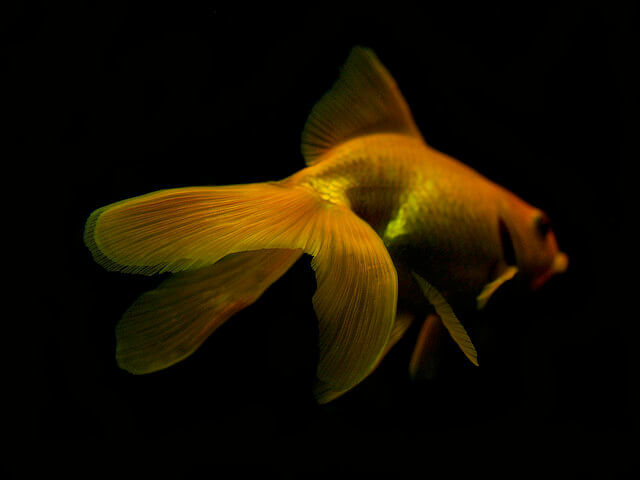 The veiltail goldfish is a popular type of goldfish among collectors and hobbyists but it a variety that is difficult to breed for showing. It's long flowing paired caudal is the veiltails most prominent feature. the caudal tail fins should not be forked or have pointed tips but be completely divided while viewed from above. When your veiltail goldfish swims, the caudal tail fins should flow elegantly in the water. Its dorsal fin should not fold over or sag but rather it should sway like a flag in the wind. The pectoral and pelvic fins should be long and narrow. Color-wise, the veiltail goldfish can be metallic self-colored (solid), variegated (multiple colors) or calico in color. The colors should strong and run into their fins.This goldfish type is not as hardy as the common, comet or ryukin goldfish but it can survive in an outdoor goldfish pond if the conditions are not too extreme. Most goldfish owners will choose to place their veiltail goldfish into their indoor aquariums.
The veiltail goldfish is a popular type of goldfish among collectors and hobbyists but it a variety that is difficult to breed for showing. It's long flowing paired caudal is the veiltails most prominent feature. the caudal tail fins should not be forked or have pointed tips but be completely divided while viewed from above. When your veiltail goldfish swims, the caudal tail fins should flow elegantly in the water. Its dorsal fin should not fold over or sag but rather it should sway like a flag in the wind. The pectoral and pelvic fins should be long and narrow. Color-wise, the veiltail goldfish can be metallic self-colored (solid), variegated (multiple colors) or calico in color. The colors should strong and run into their fins.This goldfish type is not as hardy as the common, comet or ryukin goldfish but it can survive in an outdoor goldfish pond if the conditions are not too extreme. Most goldfish owners will choose to place their veiltail goldfish into their indoor aquariums.
— Back to Top —
— Back to Top —
Globe Eye or Telescope
The Telescope Goldfish or globe eye goldfish as it is known in Europe and dragon fish in the far east is a fancy goldfish type. Protruding eyes that begin to develop around six months of age clearly explain the name of this fancy goldfish breed and make it easy to recognize if a goldfish is a telescope. A high-quality telescope goldfish has good symmetrical placement of its two eyes, each located on the outermost tip of its globe shaped protuberance. The body resembles that of the veiltail goldfish, with a short deep rounded body. Aside from the single dorsal fin, all the telescope goldfish's fins are paired and pointed, including the caudal tail fin. The dorsal fin is high on the back with a slightly elevated appearance similar to the ryukin goldfish When the telescope goldfish swims, the dorsal fin should sturdy and upright.
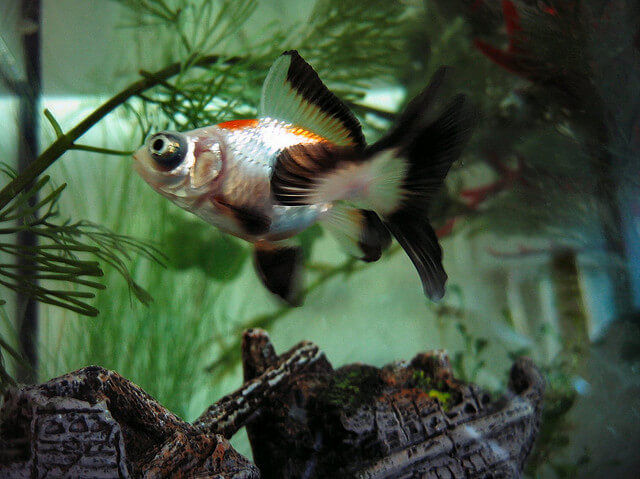
The fully divided caudal fins should be about three-quarters the length of the body of the telescope and forked about a quarter of the overall length of the caudal tail fins. When it swims the caudal tail fin should be flowing like the oranda goldfish. The telescope goldfish comes in a variety of colors: all one color (self-colored) of red, blue, chocolate, or white; bi colors (variegated) of black/white and red/white; and calico. The calico types should have a blue background with a good symmetrical balance of bright brown, orange, red yellow and violet patches, with small black spots over its entire body. There is a variety that is named a panda butterfly telescope since its colors are predominately black and white and there is also the popular broadtail moor or black moor goldfish. The telescope goldfish is hardy and can survive in cold waters, but it really should not be kept in an outdoor goldfish pond. The main reason is that is has poor vision and can't compete with other goldfish types for food. Another reason, which also has to do with their protruding eyes, is that telescope goldfish eyes are susceptible infection and injury. Make it a rule to only place these goldfish among other slow moving or delicate breeds.
— Back to Top —
Broadtail Moor
The broadtail moor goldfish or more popularly known as the black moor, should be entirely black (self-colored) throughout the body and fins. However, more often than not it contains shades of brown or silver. The color of a show quality black moor is a flat sooty color.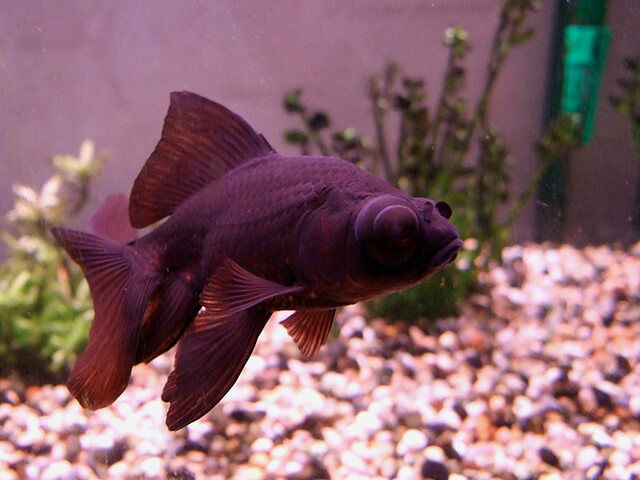 The black moor closely resembles the veiltail goldfish. The single dorsal fin should be high on the black moors back; all other fins should be paired. The paired and flowing caudal fin should be fully divided with rounded tips and have an absence of a forked appearance. It differs from the veiltail goldfish types in that the black moor has protruding eyes that resemble the telescope goldfish. A show-quality black moor will have its eye placed on the extreme tips of its protuberances. It's this style of eye that gives the black moor poor vision and is the reason you should avoid placing them into an aquarium with the more agile breeds of goldfish; they will out-compete the slower eating black moor goldfish.
The black moor closely resembles the veiltail goldfish. The single dorsal fin should be high on the black moors back; all other fins should be paired. The paired and flowing caudal fin should be fully divided with rounded tips and have an absence of a forked appearance. It differs from the veiltail goldfish types in that the black moor has protruding eyes that resemble the telescope goldfish. A show-quality black moor will have its eye placed on the extreme tips of its protuberances. It's this style of eye that gives the black moor poor vision and is the reason you should avoid placing them into an aquarium with the more agile breeds of goldfish; they will out-compete the slower eating black moor goldfish.
— Back to Top —
Oranda
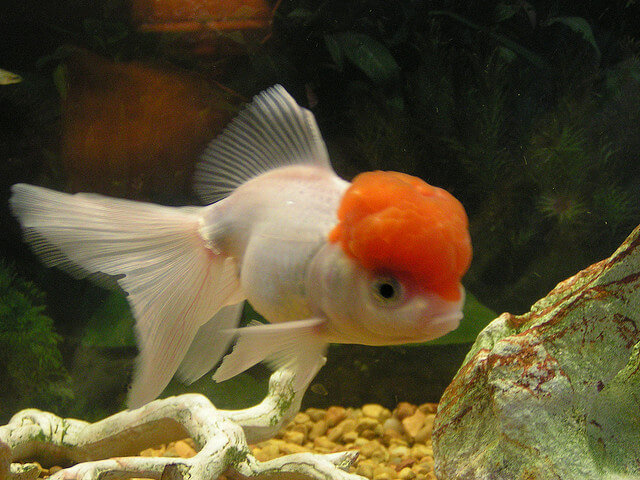 The Oranda Goldfish variety is one of the fancier types of goldfish, making orandas one of the more difficult fancy goldfish breeds to take care of. They don't do well in waters with a temperature less than 65 degrees which doesn't make them suitable for your outdoor goldfish pond. It is best to place them in your goldfish aquarium with other slow-moving fancy breeds and a few aquatic plants. Due to its body shape, oranda goldfish are slow-moving and should be feed a balanced diet to keep it from having swim bladder or constipation problems. Breeding the oranda goldfish is another challenge for goldfish breeders. It is difficult to determine the sex of orandas out of mating season but typically, males are smaller and slenderer than females. During mating season, it is easy to sex them; males produce white dots on the hoods on their heads. (Don't mistake this for goldfish ich.) If breeders are successful in mating two oranda goldfish, it is rare to get high quality fry. A high quality oranda goldfish will have a short deep body, about two thirds of its body length. The dorsal fin should be up high on its body much like the ryukin goldfish. All other fins should be long flowing and paired. The caudal should be divided and flow gracefully like the veiltail goldfish and have slightly squared trailing edges. Depending on which geographical location the oranda was bred, its caudal tail will look different. For showing purposes, the caudal tail should be deeply forked in the far east, but points are deducted for this in the west. An oranda goldfish is easily recognizable by its soft wart-like hood cover around its head. As they mature these hoods should develop around its head and face. Some orandas will develop more and some might not develop any. A good hood will have lumps of similar size that cover the entire head back to its gills. The colors of the oranda goldfish are varied: metallic, solid (self-colored), multiple colors (variegated) or calico. The redcap oranda goldfish should have a deep red hood and a silver body. Other colors include black, blue, chocolate, reds, and silvers.
The Oranda Goldfish variety is one of the fancier types of goldfish, making orandas one of the more difficult fancy goldfish breeds to take care of. They don't do well in waters with a temperature less than 65 degrees which doesn't make them suitable for your outdoor goldfish pond. It is best to place them in your goldfish aquarium with other slow-moving fancy breeds and a few aquatic plants. Due to its body shape, oranda goldfish are slow-moving and should be feed a balanced diet to keep it from having swim bladder or constipation problems. Breeding the oranda goldfish is another challenge for goldfish breeders. It is difficult to determine the sex of orandas out of mating season but typically, males are smaller and slenderer than females. During mating season, it is easy to sex them; males produce white dots on the hoods on their heads. (Don't mistake this for goldfish ich.) If breeders are successful in mating two oranda goldfish, it is rare to get high quality fry. A high quality oranda goldfish will have a short deep body, about two thirds of its body length. The dorsal fin should be up high on its body much like the ryukin goldfish. All other fins should be long flowing and paired. The caudal should be divided and flow gracefully like the veiltail goldfish and have slightly squared trailing edges. Depending on which geographical location the oranda was bred, its caudal tail will look different. For showing purposes, the caudal tail should be deeply forked in the far east, but points are deducted for this in the west. An oranda goldfish is easily recognizable by its soft wart-like hood cover around its head. As they mature these hoods should develop around its head and face. Some orandas will develop more and some might not develop any. A good hood will have lumps of similar size that cover the entire head back to its gills. The colors of the oranda goldfish are varied: metallic, solid (self-colored), multiple colors (variegated) or calico. The redcap oranda goldfish should have a deep red hood and a silver body. Other colors include black, blue, chocolate, reds, and silvers.
— Back to Top —
Pearlscale
The pearlscale goldfish with its spherical body shape and dome-like scales containing calcium carbonate, looks like a golf ball. The calcium carbonate in the scales creates a pattern of little pearl-colored domes pushing through the skin of these goldfish types. It's what one might imagine a goldfish would look like if it swallowed a golf ball whole. The small pointed head containing a little mouth is not flashy and only makes the body of the pearlscale goldfish stand out even more like the most noticeable feature.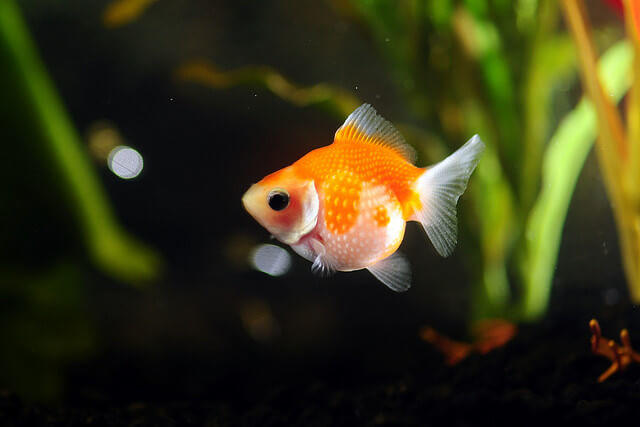 The single dorsal fin stands erect, start at the middle of the back and extends all the way to the caudal peduncle. All other fins are paired with rounded ends. The sturdy caudal fins of the pearlscale goldfish should be divided and the lobes mildly forked. As the goldfish swims, the upper lobes on the caudal fins should sit high and not drop down. The paerlscale goldfish comes in a range of colors including: metallic self-colored and variegated (a solid color or two distinct colors); calico which should be strong and balanced. This hardy bred can live in an outdoor goldfish pond but are best suited for aquariums where their unique features can really be put on display.
The single dorsal fin stands erect, start at the middle of the back and extends all the way to the caudal peduncle. All other fins are paired with rounded ends. The sturdy caudal fins of the pearlscale goldfish should be divided and the lobes mildly forked. As the goldfish swims, the upper lobes on the caudal fins should sit high and not drop down. The paerlscale goldfish comes in a range of colors including: metallic self-colored and variegated (a solid color or two distinct colors); calico which should be strong and balanced. This hardy bred can live in an outdoor goldfish pond but are best suited for aquariums where their unique features can really be put on display.
— Back to Top —
Hama Nishiki Goldfish
A cross bred between the pearlscale and the oranda. This goldfish bred looks a lot like the pearlscale, but its fins are slightly longer, and it has a small wen hood cover on top of its face that it gets from the oranda. It also grows slightly larger than the pearlscale.
— Back to Top —
Ranchu
A ranchu goldfish is a full-bodied fancy goldfish that lacks a dorsal fin and has wen hood cover much like the oranda. The back of the ranchu should have a pronounced upward arch where it curves sharply downwards at the peduncle and caudal fins. This curve directs the pair of divided caudal fins downwards. The optimal angle of the back curve and the direction of the upper lobes of the caudal fins should be 90*.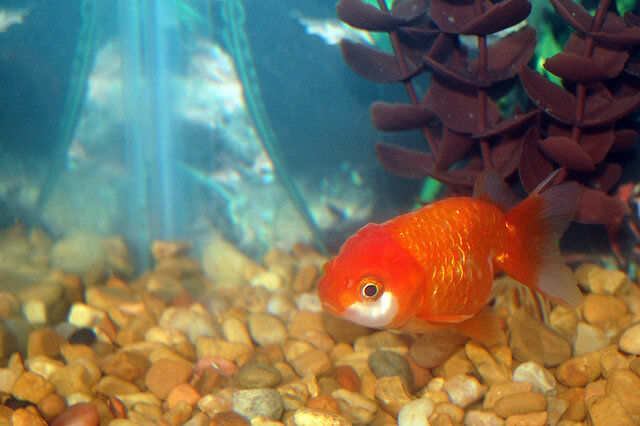 One of the most obvious features or lack thereof on a ranchu goldfish is the absence of the dorsal fin. A show quality specimen should have a clean arched back; there should be no sign of a dorsal fin, whether that be a bump or depression where the dorsal fin might have grown. The ranchu's wen hood cover should be larger than that of the oranda. It should cover the entire head and face but not the eyes. A full wen hood cover can also cover the cheeks and gill covers and resemble the mane of a lion. The Chinese version of the ranchu is called the lionhead for this reason.The ranchu goldfish from Japan and the lionhead goldfish from China are virtually the same breed with only minor differences in appearance. The back of the lionhead goldfish type lacks a serious arch and the curved peduncle is nonexistent. This allows the caudal fins to be more upright instead of being pointed downwards. A ranchu goldfish can be a metallic self-colored orange, red-and-black or a variegated multiple color, usually red and white. There are red-and-white nacreous varieties that give it a mother of pearl color called 'sakura nishiki' and there also calico nacreous colored ranchu goldfish that are called 'edo nishiki'.
One of the most obvious features or lack thereof on a ranchu goldfish is the absence of the dorsal fin. A show quality specimen should have a clean arched back; there should be no sign of a dorsal fin, whether that be a bump or depression where the dorsal fin might have grown. The ranchu's wen hood cover should be larger than that of the oranda. It should cover the entire head and face but not the eyes. A full wen hood cover can also cover the cheeks and gill covers and resemble the mane of a lion. The Chinese version of the ranchu is called the lionhead for this reason.The ranchu goldfish from Japan and the lionhead goldfish from China are virtually the same breed with only minor differences in appearance. The back of the lionhead goldfish type lacks a serious arch and the curved peduncle is nonexistent. This allows the caudal fins to be more upright instead of being pointed downwards. A ranchu goldfish can be a metallic self-colored orange, red-and-black or a variegated multiple color, usually red and white. There are red-and-white nacreous varieties that give it a mother of pearl color called 'sakura nishiki' and there also calico nacreous colored ranchu goldfish that are called 'edo nishiki'.
— Back to Top —
Pompon
The pompon goldfish is named after its most obvious feature, its fleshy lobed nasal septa that resemble pompons. These growths are connected to the goldfish's nasal septum and act as sensors for smelling airborne chemicals and odors. When fully developed, the pompon lobes can hang down into the mouth of the goldfish but in a quality specimen the pompon lobes should not hang down into the mouth. They should have a solid uniform growth and be spherical in shape. The body of a true pompon goldfish should look like the body of ranchu types without a dorsal fin. There are however breeds that have a dorsal fin or show signs of a wen head cover. Pompon goldfish come in metallic and calico colors. Pompon goldfish are best suited for goldfish aquariums with water no colder than 55*F and should not be placed in an outdoor pond. Tank mates should only include other delicate and slow-moving breeds like the telescope, oranda, bubble eye, or celestial.
— Back to Top —
Bubble Eye
The bubble eye goldfish has a similar body shape, fins, and upward pointing eyes as the celestial does, but it also has two fluid filled pouch of skin on its cheeks. A high-quality specimen will have two equally developed pouches that sit right below its eyes. As a bubble eye goldfish swims and changes direction, its pouches will bounce around and play catch up to the last move. The colors a bubble eye goldfish comes in are metallic self-colored, variegated, or calico.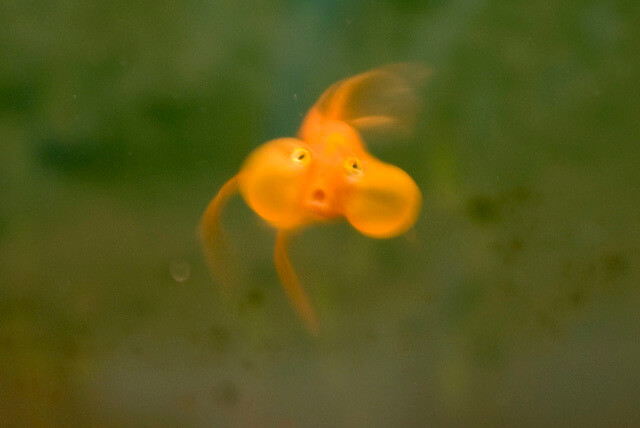 The thin skin that makes up a pouch is delicate and requires special care to ensure it is not damaged. Considerable thought should be put into what types of substrate, aquarium decorations, aquarium filters, lights and tank mates the bubble eye goldfish's tank is filled with. With the presence of these pouches, upward-pointing eyes and along with the lack of a dorsal fin, makes the bubble eye goldfish a slow swimmer with poor eye sight. Avoid any aquarium decoration or substrate that contains sharp edges. Place any air bubblers in a corner and out of the way of where the bubble eye goldfish swims. Choose a filter that doesn't have a strong intake or one that creates a strong current. Buy low wattage aquarium lights. Only place a bubble eye goldfish in with other poor seeing and slow swimming goldfish breeds like the celestial, pompon, ranchu or telescope.
The thin skin that makes up a pouch is delicate and requires special care to ensure it is not damaged. Considerable thought should be put into what types of substrate, aquarium decorations, aquarium filters, lights and tank mates the bubble eye goldfish's tank is filled with. With the presence of these pouches, upward-pointing eyes and along with the lack of a dorsal fin, makes the bubble eye goldfish a slow swimmer with poor eye sight. Avoid any aquarium decoration or substrate that contains sharp edges. Place any air bubblers in a corner and out of the way of where the bubble eye goldfish swims. Choose a filter that doesn't have a strong intake or one that creates a strong current. Buy low wattage aquarium lights. Only place a bubble eye goldfish in with other poor seeing and slow swimming goldfish breeds like the celestial, pompon, ranchu or telescope.
— Back to Top —
Celestial
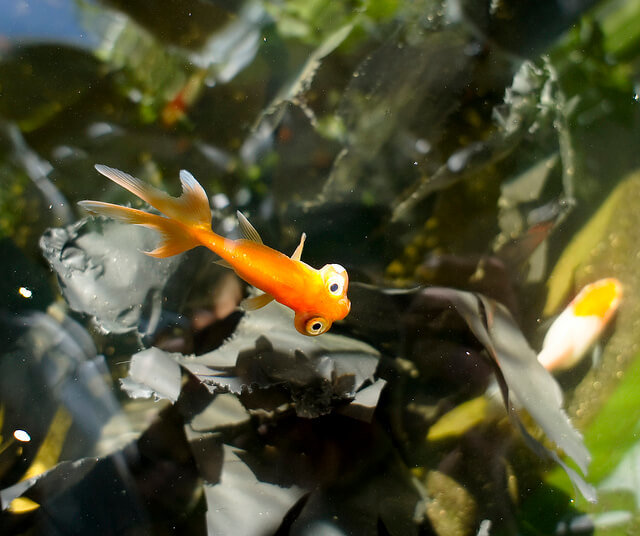 This small and delicate fancy bred of goldfish has a unique feature that needs special care to ensure the goldfish's health, making it not suitable for the beginner goldfish hobbyist. The eyes of the celestial goldfish are protruding and set to always face upwards. This feature means the celestial goldfish should not be in a tank with any decoration that can scrape or poke its eyes. The goldfish tank should not have a bright light since the celestial goldfish is always looking up while at rest. The celestial goldfish lacks a dorsal fin and when it swims it pushes its head downward to see straight ahead. This lifts its body and caudal fins upwards, making it a slow swimmer and not suitable for a tank with a water current. Tank mates should only include other celestial goldfish, bubble eyes, pompons or telescopes.
This small and delicate fancy bred of goldfish has a unique feature that needs special care to ensure the goldfish's health, making it not suitable for the beginner goldfish hobbyist. The eyes of the celestial goldfish are protruding and set to always face upwards. This feature means the celestial goldfish should not be in a tank with any decoration that can scrape or poke its eyes. The goldfish tank should not have a bright light since the celestial goldfish is always looking up while at rest. The celestial goldfish lacks a dorsal fin and when it swims it pushes its head downward to see straight ahead. This lifts its body and caudal fins upwards, making it a slow swimmer and not suitable for a tank with a water current. Tank mates should only include other celestial goldfish, bubble eyes, pompons or telescopes.
— Back to Top —
— Back to Top — Photo credits: biodork , 8113246@N02, sheffield_tiger, stwbrypocky, norman_baboo, cliche, peterrosbjerg, astrid-goes-usa/, kerjsi, amymyou, hand-nor-glove, 10349297@N00, angiehu

Article Citations and Resources
- Johnson, Erik DR.,and Richard Hess. Fancy Goldfish: Complete Guide To Care And Collecting. Weatherhill, Boston, MA. 2001.
- Boruchowitz,David. Aquarium Care of Goldfish. T.F.H Publication, Neptune City, NJ. 2008.
- Brewster, Bernice. An Essential Guide to Keeping Goldfish. Interpet Publishing, Surrey, ENG. 2003.
- Halls, Steve. Your Healthy Garden Pond. Howell Book House, Foster City, CA. 2000.
- Sweeney, Mary. The 101 Best Aquarium Plants. T.F.H, Neptune City, NJ. 2008.
- Craig A. Watson, Jeffrey E. Hill and Deborah B. Pouder. Species Profile: Koi and Goldfish. SRAC Publication No. 7201. September 2004.
| Home | How to Take Care of a Goldfish | 33 Different Types of Goldfish Breeds
How Big Do Black Tail Gold Fish Get
Source: https://www.caringpets.org/how-to-take-care-of-a-goldfish/types/